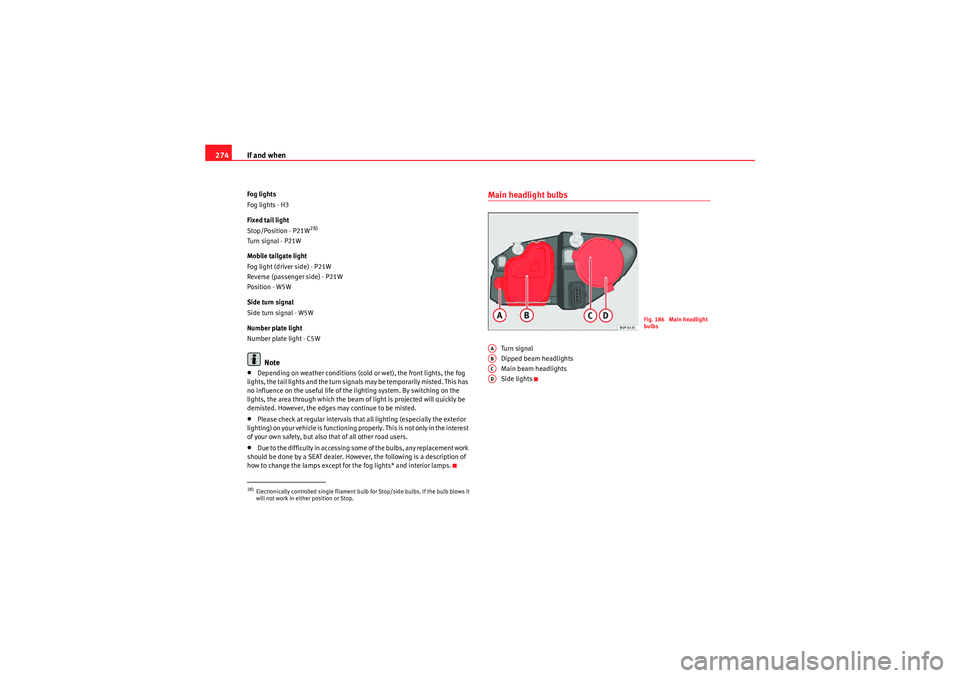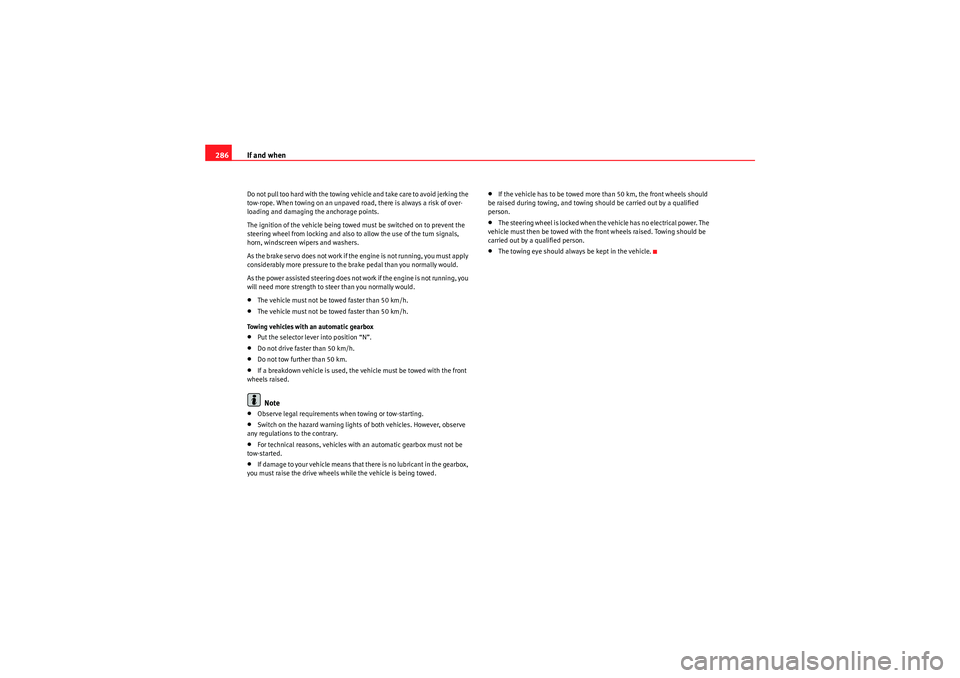Page 274 of 319

If and when
272Some of the electrical items listed in the table are only fitted on certain
models or are optional extras. Please note that the above list, while correct at the time of printing, is subject
to alterations. If discrepancies should occur, please refer to the sticker on the
inside of the fuse cover for the correct information for your model.
Fuses layout, engine compartment, left partFuses
40
Trailer control unit (turn signals, brakes and left
side)
20
41
Trailer control unit (fog light, reverse light and
right side)
20
42
BCM wiring switchboard
20
43
Trailer pre-installation
40
44
Heated rear window
25
45
Electric windows (front)
30
46
Rear electric windows
30
47
Engine (Fuel control unit, petrol relay)
15
48
Convenience controls
20
49
Heating controls
40
50
Heated seats
30
51
Sunroof
20
52
Headlight washer system
20
53
Trailer hook pre-installation assistant
20
54
Taxi (taximeter power supply)
5
55
Trailer hook pre-installation assistant
20
56
Taxi (taximeter power supply)
15
57
Telephone power supply with START STOP
10
58
Central locking control unit
30
Number
Consumer
Amps
Number
Consumer
Amps
1
Windscreen wipers
20
2
DQ200 gearbox
30
3
Cable control unit
5
4
ABS
20
5
AQ gearbox
15
6
Instrument panel/Steering column
5
7
Ignition key
40
8
Radio
15
9
Telephone/TomTom Navigator
5
10
Engine management
5
Engine management
10
11
Vacant
12
Electronic control unit
5
13
Petrol injection module supply
15
Diesel injection module supply
30
14
Coil
20
AlteaXL_EN.book Seite 272 Donnerstag, 9. September 2010 12:13 12
Page 275 of 319

If and when273
Safety First
Operating Instructions
Practical Tips
Technical Specifications
Bulb changeGeneral notesBefore changing any bulb, first turn off the failed component.
Do not touch the bulb glass. Fingerprints vaporise in the heat, causing a
reduction in the bulb life and condensation on the mirror surface, thus
reducing efficiency.
A bulb should only be replaced by one of the sam e type. The type is inscribed
on the bulb, either on the glass part or on the base.
It is highly recommended to keep a box of spare bulbs in the vehicle. At the
very least, the following spare bulbs, which are essential for road safety,
should be kept in the vehicle.
Main headlights
Dipped beam - H7
Main beam - H1
Position - W5W
Turn signal - PY21W
Xenon
26)/adaptive headlights
Dipped and full beam - D1S
27)
Daylight - P21W SLL
Position W5W
Turn signals PY21W
15
Engine management
5
Pump relay
10
16
Right lighting
30
17
Horn
15
18
Vaca n t
19
Clean
30
20
Water pump
10
Pressure sensor pump for 1.8 engine
20
21a)
Lambda probe
15
22
Brake pedal, speed sensor
5
23a)
Engine management
5
Engine management
10
Engine management
15
24
AKF, gearbox valve
10
25a)
ABS pump
40
26
Left lighting
30
27a)
Engine management
40
Engine management
50
28
Vaca n t
29a)
Electric windows (front and back)
50
Electric windows (front)
30
30
Ignition key
50
a)Ampere rating according to motorisationNumber
Consumer
Amps
26)On this type of headlight, the bulb changes must be made by the SEAT dealer, given
that complex elements must be removed from the vehicle and a reset must be made
on the automatic control system incorporated.27)The Xenon bulbs discharge 2.5 times the light flux and have an average lifespan of 5
times more than that of halogen bulbs, this means that, except due to unusual circum-
stances, there is no need to change the bulbs for the whole life of the vehicle.
AlteaXL_EN.book Seite 273 Donnerstag, 9. September 2010 12:13 12
Page 276 of 319

If and when
274Fog lights
Fog lights - H3
Fixed tail light
Stop/Position - P21W
28)
Turn signal - P21W
Mobile tailgate light
Fog light (driver side) - P21W
Reverse (passenger side) - P21W
Position - W5W
Side turn signal
Side turn signal - W5W
Number plate light
Number plate light - C5W
Note
•Depending on weather conditions (cold or wet), the front lights, the fog
lights, the tail lights and the turn signals may be temporarily misted. This has
no influence on the useful life of the lighting system. By switching on the
lights, the area through which the beam of light is projected will quickly be
demisted. However, the edges may continue to be misted.•Please check at regular intervals that all lighting (especially the exterior
lighting) on your vehicle is functioning properly. This is not only in the interest
of your own safety, but also that of all other road users.•Due to the difficulty in accessing some of the bulbs, any replacement work
should be done by a SEAT dealer. However, the following is a description of
how to change the lamps except for the fog lights* and interior lamps.
Main headlight bulbs
Turn signal
Dipped beam headlights
Main beam headlights
Side lights
28)Electronically controlled single filament bulb for Stop/side bulbs. If the bulb blows it
will not work in either position or Stop.
Fig. 186 Main headlight
bulbs
AAABACAD
AlteaXL_EN.book Seite 274 Donnerstag, 9. September 2010 12:13 12
Page 277 of 319
If and when275
Safety First
Operating Instructions
Practical Tips
Technical Specifications
Turn signal bulbs– Raise the bonnet.
– Rotate the bulb holder ⇒fig. 187 to the left and pull.
– Remove the bulb by pressing on the bulb holder and rotating at the same time to the left.
– Installation is done in the reverse order.
Dipped beam headlights– Raise the bonnet.
Fig. 187 Turn signal
AA
Fig. 188 Dipped beam
headlightsFig. 189 Dipped beam
headlights
AlteaXL_EN.book Seite 275 Donnerstag, 9. September 2010 12:13 12
Page 279 of 319
If and when277
Safety First
Operating Instructions
Practical Tips
Technical Specifications
Side lights– Raise the bonnet.
– Remove the cover ⇒fig. 192 by pulling on this. – Extract the bulb holder
⇒fig. 193 outwards.
– Replace the bulb by pulling it out and inserting the replacement.
– Installation is done in the reverse order.
Ta i l l i g h t s•On the body
– Turn signal, side and brake light•On the tailgate
– Left side: side and fog lights.
– Right side: side and reverse.
Fig. 192 Side lightsFig. 193 Side lights
AD
A1
AlteaXL_EN.book Seite 277 Donnerstag, 9. September 2010 12:13 12
Page 280 of 319
If and when
278Turn signal, side and brake lights on the body– Open the cover of the luggage compartment side panel
⇒fig. 194 . – Turn the bulb holder to the left
⇒fig. 195 .
– Remove the blown bulb and change it for a new one.
– To refit follow the steps in reverse order, taking special care when fitting the bulb holder.
Fig. 194 Lights on
vehicle bodyFig. 195 Lights on
vehicle body
AlteaXL_EN.book Seite 278 Donnerstag, 9. September 2010 12:13 12
Page 282 of 319
If and when
280Side turn signals– Press the turn signal to the left or to the right to remove the bulb.
– Remove the bulb holder from the turn signal.
– Remove the faulty bulb and replace with a new one.
– Insert the bulb holder in the turn signal guide until it clicks into
place.
– First place the turn signal in th e opening in the bodywork, fixing
the tabs ⇒fig. 198 , arrow .
– Insert the bulb as shown by the arrow ⇒fig. 198 .
Luggage compartment lights– Remove the bulb by pressing on the inside edge of this -arrow-
using the flat side of a screwdriver ⇒fig. 199.
Fig. 198 Side turn signal
A1
A2
Fig. 199 Luggage
compartment lightFig. 200 Luggage
compartment light
AlteaXL_EN.book Seite 280 Donnerstag, 9. September 2010 12:13 12
Page 288 of 319

If and when
286Do not pull too hard with the towing vehicle and take care to avoid jerking the
tow-rope. When towing on an unpaved road, there is always a risk of over-
loading and damaging the anchorage points.
The ignition of the vehicle being towed must be switched on to prevent the
steering wheel from locking and also to allow the use of the turn signals,
horn, windscreen wipers and washers.
As the brake servo does not work if the engine is not running, you must apply
considerably more pressure to the brake pedal than you normally would.
As the power assisted steering does not work if the engine is not running, you
will need more strength to steer than you normally would.•The vehicle must not be towed faster than 50 km/h.•The vehicle must not be towed faster than 50 km/h.
Towing vehicles with an automatic gearbox•Put the selector lever into position “N”.•Do not drive faster than 50 km/h.•Do not tow further than 50 km.•If a breakdown vehicle is used, the vehicle must be towed with the front
wheels raised.Note
•Observe legal requirements when towing or tow-starting.•Switch on the hazard warning lights of both vehicles. However, observe
any regulations to the contrary.•For technical reasons, vehicles with an automatic gearbox must not be
tow-started.•If damage to your vehicle means that there is no lubricant in the gearbox,
you must raise the drive wheels while the vehicle is being towed.
•If the vehicle has to be towed more than 50 km, the front wheels should
be raised during towing, and towing should be carried out by a qualified
person.•The steering wheel is locked when the vehicle has no electrical power. The
vehicle must then be towed with the front wheels raised. Towing should be
carried out by a qualified person.•The towing eye should always be kept in the vehicle.
AlteaXL_EN.book Seite 286 Donnerstag, 9. September 2010 12:13 12